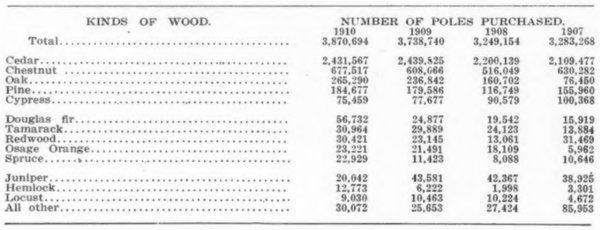[Trade Journal]
Publication: Electrical Review and Western Electrician
Chicago, IL, United States
vol. 59, no. 14, p. 670, col. 1-2
Statistics on Wooden Poles.
A preliminary statement showing the number of poles purchased by the telephone and telegraph, steam and electric railroad, and electric light and power companies in the United States during the years 1910, 1909, 1908, and 1907, was recently issued by Census Director E. Dana Durand. The data were compiled in co-operation with the Forest Service of the Department of Agriculture, and form one of the series of annual reports containing statistics in regard to the lumber and timber industries.
Of the 3,870,694 poles purchased during 1910, 2,831,810, or 73.2 per cent, were reported by telephone and telegraph companies; 733.092, or 18.9 per cent, by electric railroad, light, and power companies, and 305,792, or 7.9 per cent, by steam railroad companies.
The total number of poles purchased in 1910 by all users of these materials, while greater than the number in 1909 by only 3.5 per cent, exceeded that of 1908 by 19.1 per cent, and of 1907 by 17.9 per cent. The steam railroads reported 110,471 more poles purchased in 1910 than in 1909, and the electric railroad, light, and power companies increased their purchases by 105,678. The number reported by the telephone and telegraph companies, however, was slightly less than in the preceding year, the decrease amounting to 84,195.
In 1910, as in each of the three preceding years, more poles were cut from cedar than from all other woods combined. The proportion contributed by this species, however, has been steadily growing smaller, the percentage of cedar poles in the total of 1910 being 62.8, as against 65.3 in 1909, 67.7 in 1908, and 64.2 in 1907. Undoubtedly cedar leads all other woods in the possession of those qualities most sought after in pole material, hence the increasing proportion of other woods reported during recent years is clearly a logical result of the growing scarcity of cedar timber, together with the consequent advance in its cost. While twenty-eight different woods were reported as drawn upon for pole material during 1910, four speciesócedar, chestnut, oak, and pine, ranking in the order givenócontributed more than ninety per cent of the total during each of the four years covered by the report.
Among the woods used in relatively smaller quantities as pole material, a marked decrease is noted in the case of cypress, the number reported from this species in 1910 being only about seventy-five per cent of that shown for 1907. Principal among the causes of this decrease is, of course, the high and increasing value of this wood as lumber and shingle material. On the other hand, the number of Douglas fir poles has increased rapidly during the four years, the total reported for 1910 being nearly four times as great as that for 1907, while a substantial gain was also made for each of the intervening years.
An interesting fact disclosed by the figures is the rapid growth of the practice of treating poles in order to prolong their period of use. In 1910 824,673 poles, or more than twenty-one per cent of the total reported purchases for that year, were given some preservative treatment. This number was an increase of 248,042 poles, or 43 per cent, over that of 1909; 480,285, or 139.5 per cent, over that of 1908, and 428,474, or 108.1 per cent, over that of 1907. In 1910 the class of pole users which applied preservatives most extensively was the electric railway, light, and power companies, 29.4 per cent of the reported purchases having been given some treatment of this character, as against 19.9 per cent by steam railroads and 19.4 per cent by telephone and telegraph companies.
A comparative statement, is made in the form of the accompanying table:
 |
